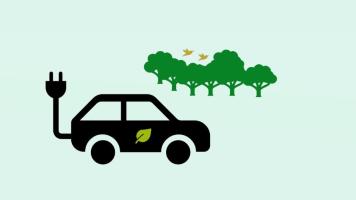Electric vehicle charging station in Viet Nam. Photo credit: ADB.
Policy recommendations include facilitating affordable and efficient home and near-home charging and supporting the establishment of fast-charging networks.
Viet Nam is ramping up adoption of electric vehicles, but the lack of charging infrastructure in the country is a major factor preventing motorists from making the shift. A 2024 study supported by ADB outlines the proactive steps that the government can take to facilitate easy access to charging facilities.
Viet Nam has set targets for increasing the share of road vehicles powered by electricity or green energy (e.g., biofuels) to 50% of all urban vehicles by 2030, 100% of urban buses and taxis by 2030, and all road vehicles by 2050. The transport sector accounts for 18% of the country's annual greenhouse gas (GHG) emissions.
The study is part of ADB’s green financing package for VinFast, which is manufacturing Viet Nam’s first fully electric public transport bus fleet and first national electric vehicle charging network. It assessed the economic, environmental, social, and infrastructure impacts of electrifying vehicles the country. It focused on fully battery electric vehicles, particularly buses, cars, and motorcycles, which are critical to reducing the road transport sector’s GHG emissions.
Cleaning the air
“Electric vehicles in Viet Nam can deliver a remarkable 60% reduction in GHG emissions compared to gasoline-powered passenger cars, as demonstrated by a life cycle assessment (LCA) that incorporates the current power grid,” which is the primary source of emissions, the study’s report says. “For motorcycles, the reduction stands at 30%, and for buses, it reaches an impressive 70%.” Emissions from battery manufacturing were also taken into account.
The study also explored ways of reducing emissions from conventional internal combustion engine (ICE) vehicles to nearly zero by 2040. It recommends setting additional targets for increasing the share of zero-emission vehicles: 100% of new passenger car sales by 2035, 100% of new sales of inter-urban and other buses by 2035, and 100% of new motorcycle sales by 2030.
Successful implementation, however, depends on solving charging problems. Policies and targeted incentives are needed to support the expansion of the charging infrastructure.
“To effectively accelerate the adoption of electric vehicles, targeted incentives for charging infrastructure are essential,” the report says. “The current lack of charging options and limited home charging availability present significant barriers to electric vehicle ownership. These challenges directly hinder people’s willingness to purchase an electric vehicle.”
A recent ADB and VinFast consumer survey showed there is increasing awareness of electric vehicles and willingness to buy them to save on fuel costs. Yet, charging issues were holding back consumers from making an actual purchase. There is a need to address range anxiety or the fear of not having enough charge to complete a journey or not being able to recharge the vehicle along the way.
“Range anxiety is a significant hurdle that must be overcome. Therefore, it is imperative to invest in a comprehensive fast-charging network for inter-urban travel and ensure ample access to chargers for residents with roadside parking or limited parking in apartments,” the report says.
Recommendations
Policy recommendations include facilitating affordable and efficient home and near-home charging and supporting the establishment of fast-charging networks with government incentives.
With the shift to electric vehicles, the study sees the demand for electricity from residential users increasing further during the evening peak hours. Implementing smart charging strategies, such as postponing charging to lower-demand hours, could ease the burden on distribution networks.
The study also looked at how the phaseout of ICE vehicles will affect workers in related industries. Job losses may be expected in the motorcycle and vehicle maintenance industry. Viet Nam does not make ICE cars and buses, but it is producing electric vehicles. This suggests the job losses will be mitigated by new opportunities not only in electric vehicle manufacturing but also in maintaining charging stations and grid infrastructure and in battery recycling.


